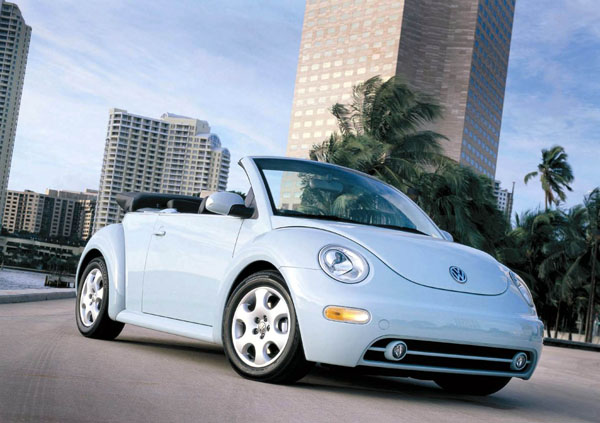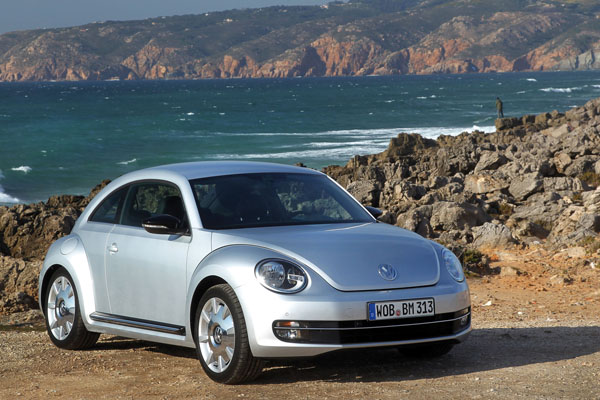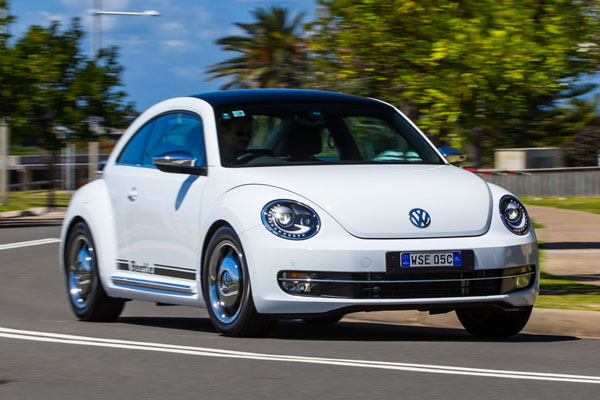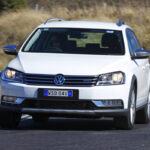
From the late 1950s and well into the ’70s the original “dak-dak” VW Beetle was a much-loved car that sold in large numbers. But it eventually become hopelessly out of date when compared with competitors and sales plummeted and it was taken off the market.
When the Volkswagen New Beetle arrived in Australia in 2000 many past owners of the original model VW looked at it with loving eyes and fond memories. Then they learned that it had a water-cooled front engine that drove the front wheels and stayed away in droves.
New Beetle began as a three-door hatchback, the back seat isn’t all that large and the shape of the rear end cuts luggage space.
A cabriolet version was launched in 2003. Its roof is a soft-top that folds down in a somewhat bulky lump. Somehow this doesn’t matter in a retro car but check out the big loss of rear vision during your pre-purchase test drive and you might not be so keen.
A minor facelift was introduced in late 2005, with new trim and revised bumpers being the biggest visual change.

In the first New Beetle all but the shortest of drivers will find themselves sitting closer to the back windscreen than the front one. There’s a huge dashtop between you and the windscreen. So, the A-pillars can confuse the view out because you sometimes have to move your head to see out of it.
A new New Beetle arrived in Australia in March 2013. It is longer and wider than the gen-one, but a little lower. There’s more room in the back seats of the gen-two, but it’s still not exactly spacious.
Style-wise, the 2013 New Beetle is considered to be less feminine than the original model. The stylists tell us there are elements of the American hotrod in the shape. If you use a fair bit of imagination you might just see that…
There are major changes inside the 2013 New Beetle. There’s no longer the feeling you’re sitting in the back of the car and peering over a vast expanse of dashtop through a small windscreen.

A variety of four-cylinder, in-line petrol and diesel engines is offered in the original New Beetle. The petrol units have capacities of 1.6, 1.8 or 2.0 litres, the diesel is offered as a 1.9 and 2.0-litre. The 1.8 is turbocharged and is used in the Beetle Turbo.
Performance from the 1.6 may be marginal for some tastes, the 2.0 is generally regarded as being a lot better.
The Beetle Turbo has decent performance but isn’t really as sporty as it may appear. Because of its added weight the cabriolet uses only the 2.0-litre engine.
The 2013 gen-two Beetle has the quirky 1.4-litre Twincharger petrol, meaning that it has supercharger and turbocharger to provide strong torque. It runs beside a six-speed manual or seven-speed double-clutch automated manual gearbox.
A car like the New Beetle just cries out to be optioned up in special editions and the marketing guys haven’t disappointed. Examples are: Beetle Ikon, sold from 2002 until 2005; Beetle Miami (a hatchback, not the convertible the name suggests) from 2004; and the Beetle Sunshine, 2001 only.
An interesting model is the Black-Orange, with paints in those colours, introduced in 2011. A Beetle Fender, named for the guitar, arrived in 2013.
Though the New Beetle has only sold in comparatively small numbers, it’s backed by one of the world’s largest car makers and many of its parts are borrowed directly from the Golf. This means spare parts and servicing are probably available in many areas of Australia, not just major cities.
Body panels are likely to be the only holdup if you need them a long way from a major population centre. Spare parts are about average in price for an imported midrange car.
You can do a fair bit of routine servicing of a New Beetle yourself. The underbonnet area is reasonably accessible and the layout restively simple. Leave all the safety items to the professionals, please.
Insurance charges are higher than average, though not to a silly level. Some companies may charge more for a Turbo.
Sales of the new New Beetle were never strong and it was quietly pulled out of the Australian market late in 2016. Some may not have been sold new till 2017, but resale value will go by the build date, not the first-sold date.
WHAT TO LOOK FOR
The original New Beetles are getting on in years. While many have been treated like babies others may have had a hard life and be near the end of their days. A professional inspection should be considered a must.
Interiors of Volkswagens generally stand up well, but some that haven’t been garaged may suffer from drying out of dashboard tops, even cracking. Repairs can be expensive.
Check the interior of a New Beetle cabriolet carefully in case it has been caught in the rain with its top down.
The engines should start quickly (even the turbo-diesel, as it has fast-acting glow plugs).
Listen for a rattling noise from the engine noises when the oil hasn’t built up to its full pressure. These could indicate major problems.
Look for smoke from the exhaust when the engine is worked hard, particularly on long uphill slogs.
Make sure a manual gearbox doesn’t baulk or crunch on fast downchanges. The clutch pedal should be reasonably light, even during these quick downchanges.
Check that conventional automatic transmissions are positive in their shifts and don’t take too long to go into Drive or Reverse from Park or Neutral.
VW had long standing problems with its DSG automated manuals. Test that it works correctly, particularly at very-slow speeds. If you have any doubts get an expert on the DSG check it out.
Feel and look for uneven tyre wear, particularly on the front wheels. Be aware that some sellers may swap tyres around to try and hide the wear.
HOW MUCH?
Budget on paying from $2000 to $5000 for a pre-2010 Volkswagen New Beetle; $5000 to $8000 for a 2013 New Beetle; $8000 to $10,000 for a 2015 model; $10,000 to $15,000 for a 2016 model; and $13,000 to $19,000 for a 2017 Classic.
CAR BUYING TIP
Want something that’s right out of the ordinary? Excellent! But be prepared to struggle with getting parts for it and finding a mechanic who knows the car.
RECALLS: To browse recalls on all vehicles go to the ACCC at: www.productsafety.gov.au/products/transport/cars/










